
Curved mirror
Encyclopedia

Mirror
A mirror is an object that reflects light or sound in a way that preserves much of its original quality prior to its contact with the mirror. Some mirrors also filter out some wavelengths, while preserving other wavelengths in the reflection...
with a curved reflective surface, which may be either convex (bulging outward) or concave (bulging inward). Most curved mirrors have surfaces that are shaped like part of a sphere
Sphere
A sphere is a perfectly round geometrical object in three-dimensional space, such as the shape of a round ball. Like a circle in two dimensions, a perfect sphere is completely symmetrical around its center, with all points on the surface lying the same distance r from the center point...
, but other shapes are sometimes used in optical devices. The most common non-spherical type are parabolic reflector
Parabolic reflector
A parabolic reflector is a reflective device used to collect or project energy such as light, sound, or radio waves. Its shape is that of a circular paraboloid, that is, the surface generated by a parabola revolving around its axis...
s, found in optical devices such as reflecting telescope
Reflecting telescope
A reflecting telescope is an optical telescope which uses a single or combination of curved mirrors that reflect light and form an image. The reflecting telescope was invented in the 17th century as an alternative to the refracting telescope which, at that time, was a design that suffered from...
s that need to image distant objects, since spherical mirror systems suffer from spherical aberration
Spherical aberration
thumb|right|Spherical aberration. A perfect lens focuses all incoming rays to a point on the [[Optical axis|optic axis]]. A real lens with spherical surfaces suffers from spherical aberration: it focuses rays more tightly if they enter it far from the optic axis than if they enter closer to the...
.
Convex mirrors
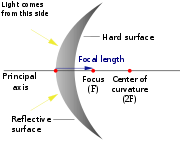
Virtual image
In optics, a virtual image is an image in which the outgoing rays from a point on the object always diverge. It will appear to converge in or behind the optical device . A simple example is a flat mirror where the image of oneself is perceived at twice the distance from oneself to the mirror...
, since the focus
Focus (optics)
In geometrical optics, a focus, also called an image point, is the point where light rays originating from a point on the object converge. Although the focus is conceptually a point, physically the focus has a spatial extent, called the blur circle. This non-ideal focusing may be caused by...
(F) and the centre of curvature (2F) are both imaginary points "inside" the mirror, which cannot be reached. As a result, images formed by these mirrors cannot be projected on a screen, since the image is inside the mirror.
A collimated
Collimated light
Collimated light is light whose rays are parallel, and therefore will spread slowly as it propagates. The word is related to "collinear" and implies light that does not disperse with distance , or that will disperse minimally...
(parallel) beam of light diverges (spreads out) after reflection from a convex mirror, since the normal
Surface normal
A surface normal, or simply normal, to a flat surface is a vector that is perpendicular to that surface. A normal to a non-flat surface at a point P on the surface is a vector perpendicular to the tangent plane to that surface at P. The word "normal" is also used as an adjective: a line normal to a...
to the surface differs with each spot on the mirror.
Uses

.jpg)
Čar
Čar is a village in the municipality of Bujanovac, Serbia. According to the 2002 census, the town has a population of 296 people.-References:...
is typically a convex mirror. In some countries, these are labeled with the safety warning "Objects in mirror are closer than they appear", to warn the driver of the convex mirror's distorting effects on distance perception. Convex mirrors are preferred in vehicles because they give an upright, though diminished, image. Also they provide a wider field of view as they are curved outwards.
Convex mirrors are used in some automated teller machine
Automated teller machine
An automated teller machine or automatic teller machine, also known as a Cashpoint , cash machine or sometimes a hole in the wall in British English, is a computerised telecommunications device that provides the clients of a financial institution with access to financial transactions in a public...
s as a simple and handy security feature, allowing the users to see what is happening behind them. Similar devices are sold to be attached to ordinary computer monitors.
Some camera phone
Camera phone
A camera phone is a mobile phone which is able to capture still photographs . Since early in the 21st century the majority of mobile phones in use are camera phones....
s use convex mirrors to allow the user to correctly aim the camera while taking a self-portrait
Self-portrait
A self-portrait is a representation of an artist, drawn, painted, photographed, or sculpted by the artist. Although self-portraits have been made by artists since the earliest times, it is not until the Early Renaissance in the mid 15th century that artists can be frequently identified depicting...
.
Round convex mirrors called Oeil de Sorcière (French for "sorcerer's eye") were a popular luxury item from the 15th century onwards, shown in many depictions of interiors from that time. With 15th century technology, it was easier to make a regular curved mirror (from blown glass) than a perfectly flat one. They were also known as "bankers' eyes" due to the fact that their wide field of vision was useful for security. Famous examples in art include the Arnolfini Portrait
Arnolfini portrait
The Arnolfini Portrait is an oil painting on oak panel dated 1434 by the Early Netherlandish painter Jan van Eyck. It is also known as The Arnolfini Wedding, The Arnolfini Marriage, The Arnolfini Double Portrait or the Portrait of Giovanni Arnolfini and his Wife, among other titles...
by Jan van Eyck
Jan van Eyck
Jan van Eyck was a Flemish painter active in Bruges and considered one of the best Northern European painters of the 15th century....
and the left wing of the Werl Altarpiece by Robert Campin
Robert Campin
Robert Campin , now usually identified as the artist known as the Master of Flémalle, is usually considered the first great master of Early Netherlandish painting...
.
Image
The image on a convex mirror is always virtual (raysRay (optics)
In optics, a ray is an idealized narrow beam of light. Rays are used to model the propagation of light through an optical system, by dividing the real light field up into discrete rays that can be computationally propagated through the system by the techniques of ray tracing. This allows even very...
haven't actually passed through the image, their extensions do, like in a regular mirror), diminished (smaller), and upright. As the object gets closer to the mirror, the image gets larger, until reaching approximately the size of the object, when it touches the mirror. As the object moves away, the image diminishes in size and gets gradually closer to the focus, until it is reduced to a point in the focus when the object is at an infinite distance. These features make convex mirrors very useful: since everything appears smaller in the mirror, they cover a wider field of view
Angle of view
In photography, angle of view describes the angular extent of a given scene that is imaged by a camera. It is used interchangeably with the more general term field of view....
than a normal plane mirror
Mirror
A mirror is an object that reflects light or sound in a way that preserves much of its original quality prior to its contact with the mirror. Some mirrors also filter out some wavelengths, while preserving other wavelengths in the reflection...
does.
| Object's position (S), focal point (F) |
Image | Diagram |
|---|---|---|
 |
|
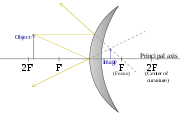 |
Concave mirrors
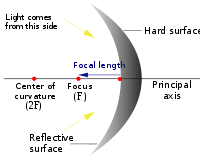
These mirrors are called "converging" because they tend to collect light that falls on them, refocusing parallel incoming rays
Ray (optics)
In optics, a ray is an idealized narrow beam of light. Rays are used to model the propagation of light through an optical system, by dividing the real light field up into discrete rays that can be computationally propagated through the system by the techniques of ray tracing. This allows even very...
toward a focus. This is because the light is reflected at different angles, since the normal to the surface differs with each spot on the mirror.
Image
| Object's position (S), focal point (F) |
Image | Diagram |
|---|---|---|
 (Object between focal point and mirror) |
|
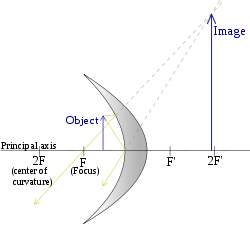 |
 (Object at focal point) |
Limit (mathematics) In mathematics, the concept of a "limit" is used to describe the value that a function or sequence "approaches" as the input or index approaches some value. The concept of limit allows mathematicians to define a new point from a Cauchy sequence of previously defined points within a complete metric... where S approaches F, the image distance approaches infinity Infinity Infinity is a concept in many fields, most predominantly mathematics and physics, that refers to a quantity without bound or end. People have developed various ideas throughout history about the nature of infinity... , and the image can be either real or virtual and either upright or inverted depending on whether S approaches F from above or below. |
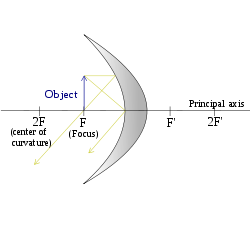 |
 (Object between focus and centre of curvature) |
|
 |
 (Object at centre of curvature) |
|
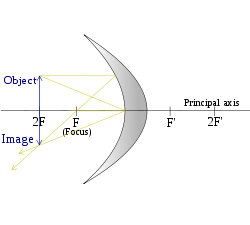 |
 (Object beyond centre of curvature) |
|
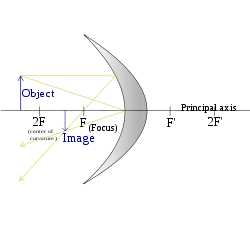 |
Mirror shape
Most curved mirrors have a spherical profile. These are the simplest to make, and it is the best shape for general-purpose use. Spherical mirrors, however, suffer from spherical aberrationSpherical aberration
thumb|right|Spherical aberration. A perfect lens focuses all incoming rays to a point on the [[Optical axis|optic axis]]. A real lens with spherical surfaces suffers from spherical aberration: it focuses rays more tightly if they enter it far from the optic axis than if they enter closer to the...
. Parallel rays reflected from such mirrors do not focus to a single point. For parallel rays, such as those coming from a very distant object, a parabolic reflector
Parabolic reflector
A parabolic reflector is a reflective device used to collect or project energy such as light, sound, or radio waves. Its shape is that of a circular paraboloid, that is, the surface generated by a parabola revolving around its axis...
can do a better job. Such a mirror can focus incoming parallel rays to a much smaller spot than a spherical mirror can.
Mirror equation and magnification
The GaussianGaussian optics
Gaussian optics is a technique in geometrical optics that describes the behaviour of light rays in optical systems by using the paraxial approximation, in which only rays which make small angles with the optical axis of the system are considered. In this approximation, trigonometric functions can...
mirror equation relates the object distance
 and image distance
and image distance  to the focal length
to the focal length  :
: .
.The sign convention
Sign convention
In physics, a sign convention is a choice of the physical significance of signs for a set of quantities, in a case where the choice of sign is arbitrary. "Arbitrary" here means that the same physical system can be correctly described using different choices for the signs, as long as one set of...
used here is that the focal length is positive for concave mirrors and negative for convex ones, and
 and
and  are positive when the object and image are in front of the mirror, respectively. (They are positive when the object or image is real.)
are positive when the object and image are in front of the mirror, respectively. (They are positive when the object or image is real.)For convex mirrors, if one moves the
 term to the right side of the equation to solve for
term to the right side of the equation to solve for  , the result is always a negative number, meaning that the image distance is negative—the image is virtual, located "behind" the mirror. This is consistent with the behavior described above.
, the result is always a negative number, meaning that the image distance is negative—the image is virtual, located "behind" the mirror. This is consistent with the behavior described above.For concave mirrors, whether the image is virtual or real depends on how large the object distance is compared to the focal length. If the
 term is larger than the
term is larger than the  term,
term,  is positive and the image is real. Otherwise, the term is negative and the image is virtual. Again, this validates the behavior described above.
is positive and the image is real. Otherwise, the term is negative and the image is virtual. Again, this validates the behavior described above.The magnification
Magnification
Magnification is the process of enlarging something only in appearance, not in physical size. This enlargement is quantified by a calculated number also called "magnification"...
of a mirror is defined as the height of the image divided by the height of the object:
 .
.By convention, if the resulting magnification is positive, the image is upright. If the magnification is negative, the image is inverted (upside down).
Ray tracing
The image location and size can also be found by graphical ray tracing, as illustrated in the figures above. A ray drawn from the top of the object to the surface vertex (where the optical axisOptical axis
An optical axis is a line along which there is some degree of rotational symmetry in an optical system such as a camera lens or microscope.The optical axis is an imaginary line that defines the path along which light propagates through the system...
meets the mirror) will form an angle
Angle
In geometry, an angle is the figure formed by two rays sharing a common endpoint, called the vertex of the angle.Angles are usually presumed to be in a Euclidean plane with the circle taken for standard with regard to direction. In fact, an angle is frequently viewed as a measure of an circular arc...
with that axis. The reflected ray has the same angle to the axis, but is below it (See Specular reflection
Specular reflection
Specular reflection is the mirror-like reflection of light from a surface, in which light from a single incoming direction is reflected into a single outgoing direction...
).
A second ray can be drawn from the top of the object passing through the focal point and reflecting off the mirror at a point somewhere below the optical axis. Such a ray will be reflected from the mirror as a ray parallel
Parallel (geometry)
Parallelism is a term in geometry and in everyday life that refers to a property in Euclidean space of two or more lines or planes, or a combination of these. The assumed existence and properties of parallel lines are the basis of Euclid's parallel postulate. Two lines in a plane that do not...
to the optical axis. The point at which the two rays described above meet is the image point corresponding to the top of the object. Its distance from the axis defines the height of the image, and its location along the axis is the image location. The mirror equation and magnification equation can be derived geometrically by considering these two rays.
Ray transfer matrix of spherical mirrors
The mathematical treatment is done under the paraxial approximationParaxial approximation
In geometric optics, the paraxial approximation is a small-angle approximation used in Gaussian optics and ray tracing of light through an optical system ....
, meaning that under the first approximation a spherical mirror is a parabolic reflector
Parabolic reflector
A parabolic reflector is a reflective device used to collect or project energy such as light, sound, or radio waves. Its shape is that of a circular paraboloid, that is, the surface generated by a parabola revolving around its axis...
.
The ray matrix
Ray transfer matrix analysis
Ray transfer matrix analysis is a type of ray tracing technique used in the design of some optical systems, particularly lasers...
of a spherical mirror is shown here for the concave reflecting surface of a spherical mirror. The
 element of the matrix is
element of the matrix is  , where
, where  is the focal point of the optical device.
is the focal point of the optical device.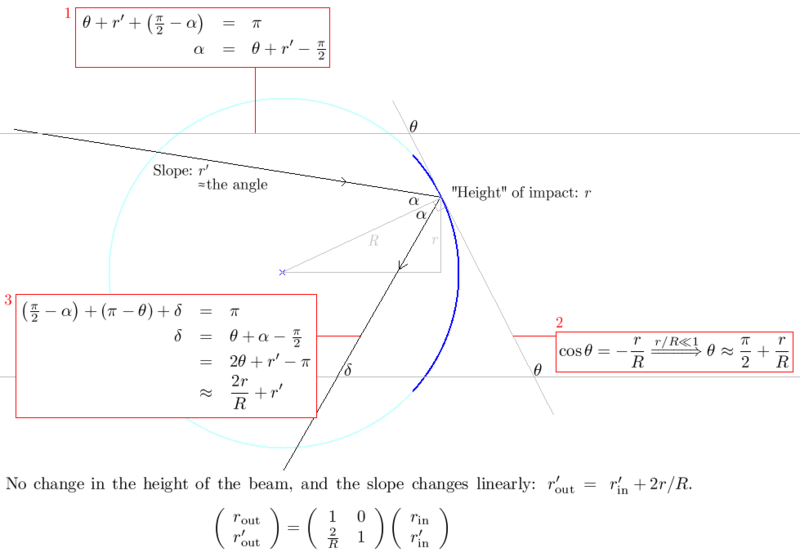
Boxes 1 and 3 feature summing the angles of a triangle and comparing to π radians (or 180°). Box 2 shows the Maclaurin series of
 up to order 1. The derivations of the ray matrices of a convex spherical mirror and a thin lens
up to order 1. The derivations of the ray matrices of a convex spherical mirror and a thin lensThin lens
[Image:Lens1.svg|thumb|A lens can be considered a thin lens if d [Image:Lens1.svg|thumb|A lens can be considered a thin lens if d [Image:Lens1.svg|thumb|A lens can be considered a thin lens if d...
are very similar.
External links
- http://www.school-for-champions.com/science/experiments/simopticsmirror.htm Java Applet to explore ray tracing.
- http://www.phys.ufl.edu/~phy3054/light/mirror/applets/Welcome.html Java applets to explore ray tracing for curved mirrors.
- Concave mirrors — real images Molecular Expressions Optical Microscopy Primer.
- Spherical mirrors Online physics lab.
- "Grinding the World's Largest Mirror" Popular Science, December 1935

